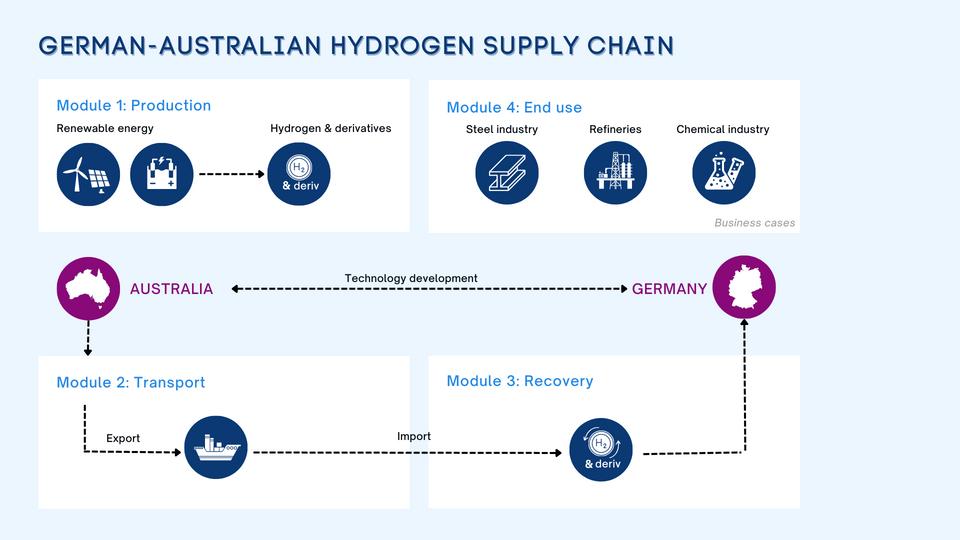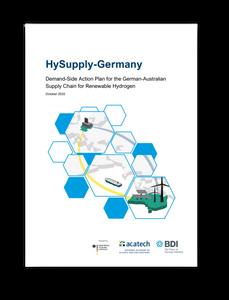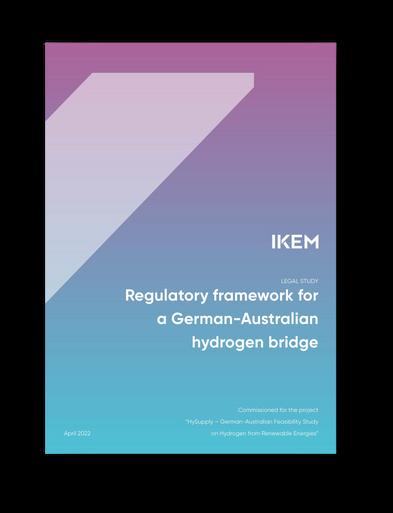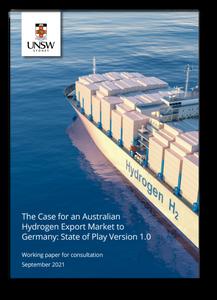
4 minute read
THE HYSUPPLY PROJECT
HySupply is a collaboration between Germany and Australia to investigate the feasibility of exporting renewable energy in the form of hydrogen from Australia to Germany and identify how this partnership can be facilitated The project arose from a previous cooperation project, Pathways to the Future of Energy [1], where a fact finding mission by a German delegation in Autumn 2019 met with leading Australian research institutions and companies in the field of energy and hydrogen The key finding of the trip: Australia is a suitable partner for a long-term hydrogen partnership with Germany

This led to the Joint Declaration of Intent on an Australian-German Supply Chain Feasibility Study of Hydrogen produced from Renewables signed by the Australian and German Governments in 2020 For Australia, the consortium is led by UNSW Sydney and is funded by the Department of Foreign Affairs and Trade (DFAT) and the Department of Industry, Science, Energy and Resources (DISER) For Germany, the project is led by the German National Academy of Science and Engineering (acatech) together with the Federation of German Industries (BDI) and is funded by the Federal Ministry for Education (BMBF). Together, the two sides brought together a unique network of companies and scientific experts to investigate the entire value chain of renewable hydrogen and hydrogen derivative production in Australia to its shipping and then potential use cases in Germany
[1] https://en acatech de/publication/pathways-into-the-energy-future/
A key finding of the study is that Australia and Germany are natural partners in this energy export value chain Australia’s renewable energy resources, energy export credentials and ability to deliver mega-scale energy projects at scale makes it a well-placed contender for this collaboration Germany’s strong net zero commitments and expertise in clean technology makes an ideal fit to import renewable hydrogen and co-develop Australia’s hydrogen capability. This alignment is increasingly recognised by industry partners in both countries and there are now at least eight bilateral MoUs signed to advance this trade. However, while there is much to be optimistic about, there is much more still to be done This final report of the joint Australian and German HySupply consortia is intended to summarise the findings of the two year project, and highlight key actions for stakeholders to achieve the potential of this renewable hydrogen supply chain
Hysupply Deliverables
Officially kicking off in December 2020 with a bilateral workshop with industry and academic stakeholders, the first formal output of HySupply was the German Meta-Analysis (July 2021), which explored the hydrogen carrier options from Australia to Germany, focusing on the elements for seaborn transport of hydrogen including conversion, storage, shipping, and reconversion and status of these technologies and their potential for scalability by 2030
This was followed by Australian HySupply State of Play report, released in September 2021, which assessed Australia’s potential for major green hydrogen production and export capabilities This is done to provide both German and Australian stakeholders with an overview of how Australia’s well established and globally leading role in conventional energy exports, and world-class renewables resources, can be leveraged for the development of a new export energy value chain assisting other countries such as Germany to achieve their clean energy objectives. The report aimed to enhance the shared understanding of industry, government and private sectors across Australia and Germany around the challenges as well as opportunities of such trade
Assessment of the value chain was then complemented by Australia HySupply Consortium releasing a series of open-source modelling tools (October 2021-tll now) for investigating the cost of generating hydrogen, its subsequent conversion to carriers such as ammonia and methanol, and its transport

HySupply Germany then carried out a legal review (April 2022) of the identified transport pathways in their Meta-Analysis, identifying legal roadblocks that needs addressing for unlocking this value chain.
Australian HySupply then carried out a Supply Side Roadmapping exercise (May 2022) with over 50 stakeholders to identify key barriers and opportunities across thematic areas and formulating strategic steps from now till 2025, 2025 to 2030 and 2030 onwards to realise Australia’s hydrogen export potential
HysupplyAustralia's State of Play Report (2021)
HySupplyGermany's MetaAnalysis (2021)
HySupplyAustralia's Open Source Models (2021-2022)
HySupplyGermany's Legal Study (2022)
HysupplyAustralia's Supply-side Roadmapping Exercise (2022)
HysupplyAustralia's Certification Report (2022)
HysupplyGermany's Demand-Side Action Plan (2022)
HySupply Final Report (2023)

May 2022 also saw a combined German government, academia and industry delegation visit Australia, visiting industry partners, state government representatives and projects in Western Australia, New South Wales, Queensland and South Australia A HySupply event was hosted in UNSW bringing together Australian partners and German partners of HySupply where dialogue was held on challenges and how to take the partnership further
In June 2022, HySupply-Australia, led by ANU, also released the Approaches to certifying Australia-Germany Green Hydrogen Supply Chains report, that described key characteristics and ‘good design’ principles of certification schemes as well as existing and emerging certification schemes that are potentially applicable to bilateral trade of renewable hydrogen between Australia and Germany








Led by CSIRO and with HySupply participation, an academic delegation visit to Germany was undertaken in September 2022 as part of the International Hydrogen Research Collaboration Program supported by DCCEEW It visited a range of industry and research centres and concluded with an event at the Australian Embassy in Berlin, hosted by Ambassador Philip Green
In October 2022, HySupply Germany released the DemandSide Action Plan that provides an update on Germany’s evolving hydrogen economy and formulates actions that need to be implemented within the next 24 months to allow for renewable hydrogen imports from Australia by 2030 the latest

Next Steps
This is the final joint report of the HySupply project However, HySupply is only one of numerous joint initiatives, government and industry, between Australia and Germany seeking to advance clean energy trade amongst the two countries While the joint project officially closes with this final report, there is some further work underway by HySupply Australia in 2023, including a report exploring electricity market configurations for large-scale electrolyser operations, an assessment on viable carbon sources and technologies for synthetic fuel production and further open-source costing tools.
As discussed in the Summary Section, the HySupply collaboration recommends a central platform for continuing, expanding and better coordinate the hydrogen partnership between Australia and Germany, bringing together representatives of existing initiatives to better coordinate and align activities including funding and external stakeholder engagement






